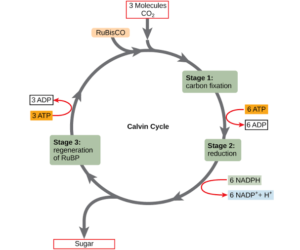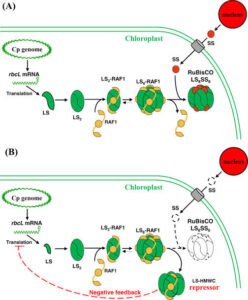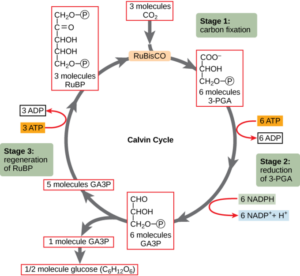Back to: Botany 200 Level
Hello, dear learner! I hope you’re having a fantastic day! Have you ever wondered how plants turn the carbon dioxide (CO₂) we breathe out into food? Imagine a chef taking simple ingredients and turning them into a delicious meal. In plants, the process of carbon fixation does something similar—it takes carbon from the air and turns it into glucose, the food plants use for energy. And the star of this process? A special enzyme called RuBisCO! Today, we’ll learn all about carbon fixation and why RuBisCO is one of the most important enzymes in the world.
Carbon fixation and the role of RuBisCO
Plants can’t survive on sunlight alone. While light-dependent reactions produce ATP and NADPH, these molecules only store energy temporarily. To make glucose (a stable energy source), plants must fix carbon dioxide through a process called the Calvin cycle.

What Is Carbon Fixation?
Carbon fixation is the process where inorganic CO₂ from the air is converted into organic molecules (glucose) that plants can use for growth and energy. This process happens in the stroma of the chloroplast and is part of the Calvin cycle.
The Role of RuBisCO in Carbon Fixation
RuBisCO (Ribulose-1,5-bisphosphate carboxylase/oxygenase) is an enzyme that catalyses (speeds up) the first step of carbon fixation. It is the most abundant protein on Earth because every green plant, algae, and photosynthetic bacterium depends on it!
How Does RuBisCO Work?
CO₂ Enters the Cycle: Carbon dioxide from the atmosphere enters the chloroplast and binds to a molecule called RuBP (Ribulose-1,5-bisphosphate).
RuBisCO Catalyses the Reaction: RuBisCO helps attach CO₂ to RuBP, forming an unstable 6-carbon compound.

Splitting into 3-PGA: This compound immediately breaks into two molecules of 3-PGA (3-phosphoglycerate), which will later be converted into glucose.
The Calvin Cycle (Carbon Fixation Process)
Carbon fixation is the first phase of the Calvin cycle. Here’s a simple breakdown of the full cycle:
Carbon Fixation: RuBisCO attaches CO₂ to RuBP, forming 3-PGA.
Reduction Phase: ATP and NADPH convert 3-PGA into G3P (Glyceraldehyde-3-phosphate), a simple sugar molecule.
Regeneration of RuBP: Some G3P is used to regenerate RuBP, ensuring the cycle continues.
Glucose Formation: The remaining G3P molecules eventually form glucose, which plants use for energy.
Why Is RuBisCO So Important?
It enables plants to make food. Without RuBisCO, plants couldn’t turn CO₂ into glucose.
It supports life on Earth. The oxygen we breathe and the food we eat come from RuBisCO-powered carbon fixation!

It influences climate balance. Plants absorb CO₂ from the air, helping reduce greenhouse gases.
Limitations of RuBisCO
While RuBisCO is essential, it has a major flaw:
It sometimes binds to oxygen (O₂) instead of CO₂, leading to photorespiration, a wasteful process that reduces food production.
To overcome this, some plants (like maize and sugarcane) have evolved a C4 pathway, while desert plants use CAM photosynthesis to improve carbon fixation.
Summary
Carbon fixation is the process by which plants turn carbon dioxide into glucose, providing food and energy. The enzyme RuBisCO plays a key role by attaching CO₂ to RuBP in the Calvin cycle. Even though RuBisCO sometimes makes mistakes by binding to oxygen, it remains one of the most important proteins in the world, keeping plants—and life on Earth—alive!
Let’s Test Your Understanding:
- What is the main role of RuBisCO in carbon fixation?
- Where does carbon fixation take place in the chloroplast?
- Why is photorespiration considered wasteful?
Excellent work, superstar! Keep up the great learning, and always remember—every leaf around you is busy fixing carbon, turning air into food, thanks to the incredible RuBisCO! See you in the next lesson!
